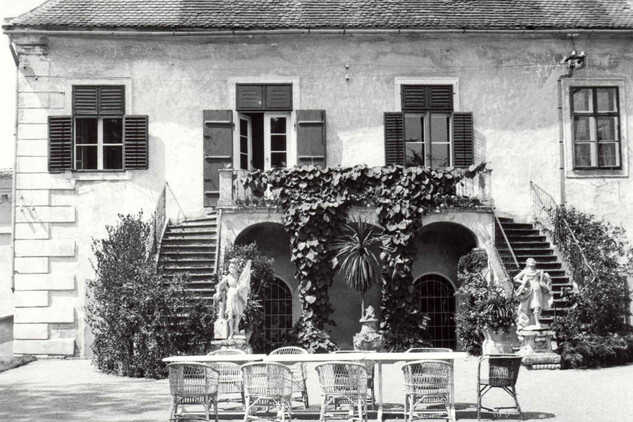Vážení návštěvníci, zámek je otevřen ve dnech 1. a 2. 11. - klasické prohlídky základního okruhu “Zámecké interiéry” jsou v 10:00 a 13:00
Zvířata v zámeckém parku
Anglický park u zámku v Uherčicích přechází téměř ze všech stran do volné krajiny. Z tohoto důvodu byl a je domovem řady zvířat, které v něm hledají útočiště. Až do roku 1990 spadalo okolí Uherčic do ostře sledovaného hraničního pásma s Rakouskem, což nerušený život zdejších zvířecích obyvatel velmi ulehčovalo. Z okolních lesů a polí se do parku čas od času zatoulají rodiny srn, divoká prasata, kuny, lišky či jezevci. Mezi stromy v parku hledají potravu a útočiště také nejrůznější hraboši, dále zajíci či bažanti. kteří byli v původní bažantnici na místě parku cíleně chováni už v 18. století. Vzhledem k nepříliš vzdálenému národnímu parku Podyjí, kde přebývá mnoho druhů vzácných opeřenců, je zámecký les, podobně jako celé pohraničí, také významným hnízdištěm či přechodným bydlištěm řady ptáků. Mezi nimi je možné zahlédnout datla černého, holuba doupňáka, lejska bělokrkého, skřivana lesního, ťuhýka obecného, žlunu šedou a zcela výjimečně i výra velkého. Uherčice leží v krajině mezi Podyjím a přírodním parkem Česká Kanada, což ovlivňuje výskyt čím dál vzácnějších brouků a dalšího hmyzu. Listím a trávou v parku se prodírají zlatohlávci zlatí, nosorožíci kapucínci, střevlíci, roháči obecní a v jarních či letních měsících vzduchem poletují hnědásci rozraziloví, modrásci hořcoví nebo ohniváčci černočární. Půdy, sklepy a místnosti zámku v Uherčicích jsou také evropsky chráněnou lokalitou, kde se vyskytuje vzácný druh netopýra – vrápenec malý. Zkrátka – stačí se jen na chvíli zastavit a potichu se rozhlédnout kolem sebe.
On practically all sides, the English park at Uherčice Château gradually blends into free, unregulated landscape. This is why it has been home to large numbers animals seeking refuge on its grounds. Until 1990, the land around the château was part of the heavily surveilled Czech-Austrian border zone, which made the undisturbed life of the local fauna even more convenient. From time to time, families of deer, wild boars, martens, foxes, and badgers stray into the park. Various kinds of voles and hares forage for food and seek shelter among the trees in the grounds, as do pheasants that were bred here as early as the eighteenth century in the pheasantry that predated the park. Due to the proximity of the Podyjí National Park (habitat of numerous rare avian species), the château woods – similarly to the rest of the borderlands – are an important nesting site and temporary habitat for many kinds of birds. These include the black woodpecker, stock dove, collared flycatcher, woodlark, red-back shrike, grey-headed woodpecker, and, quite rarely, also the Eurasian eagle-owl. Uherčice Château is situated in the landscape between Podyjí and the Česká Kanada Nature Park, which entails the occurrence of some increasingly rare insect species in the park. Here, green rose chafers, European rhinoceros beetles, ground beetles, and European stag beetles crawl through the foliage and grass and, in the spring and summer months, false heath fritillaries, Alcon blues, and large copper butterflies flutter through the air. Moreover, the cellars, attics, and rooms of the château are listed as a European protected site, being the habitat of the rare lesser horseshoe bat. In short, all you need to do is to quietly pause for a moment and have a look around.
Englischer Park bei dem Schloss in Uherčice geht von fast allen Seiten in die offene Landschaft über. Aus diesem Grunde war und ist er Heimat vieler Tiere, die in seinem Wald Zuflucht suchten. Bis 1990 fiel die Umgebung von Uherčice in die streng überwachte Grenzzone zu Österreich, was das ungestörte Leben der einheimischen Tierpopulation erheblich erleichterte. Aus den Wäldern in der Umgebung ziehen durch den Park ab und zu Hirschfamilien, Wildschweine, Marder, Füchse oder Dachse. Unter den Bäumen suchen ihre Nahrung und Zuflucht verschiedene Wühlmäuse, weiter auch Hasen und Fasanen, die bereits im 18. Jahrhundert in der ursprünglichen Fasanerie auf dem Gelände des Parks absichtlich gezüchtet wurden. Aufgrund des nicht allzu weit entfernten Nationalparks Podyjí, in dem viele seltene Vogelarten leben, ist der Schlosswald, wie das gesamte Grenzland, auch ein wichtiger Nistplatz oder vorübergehender Aufenthaltsort für viele Vögel. Unter ihnen sind Schwarzspecht, Hohltaube, Halsbandschnäpper, Waldlerche, Neuntöter, Grauspecht und sehr seltener Uhu zu sehen. Uherčice liegt in der Landschaft zwischen Podyjí und dem Naturpark Česká Kanada, was das Vorkommen von bedrohten Käfern und anderen Insekten beeinflusst. Durch Blätter und Gras im Park bummeln Goldglänzender Rosenkäfer, Nashornkäfer, Laufkäfer, Hirschkäfer und im Frühling und im Sommer tanzen da in der Luft Baldrian-Scheckenfalter, Kleiner Moorbläuling oder die Großen Feuerfalter. Die Dachböden, Keller und Räume des Schlosses in Uherčice sind auch eine geschützte europäische Lokalität, die die seltene Fledermaus Kleine Hufeisennase bewohnt. Es reicht einfach, wenn man für einen Moment Halt macht und sich still umsieht.

